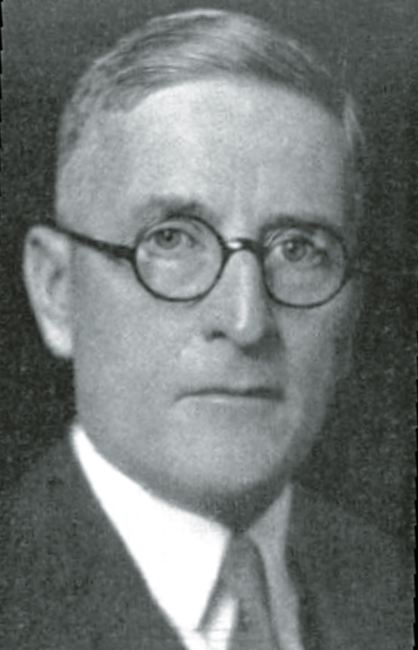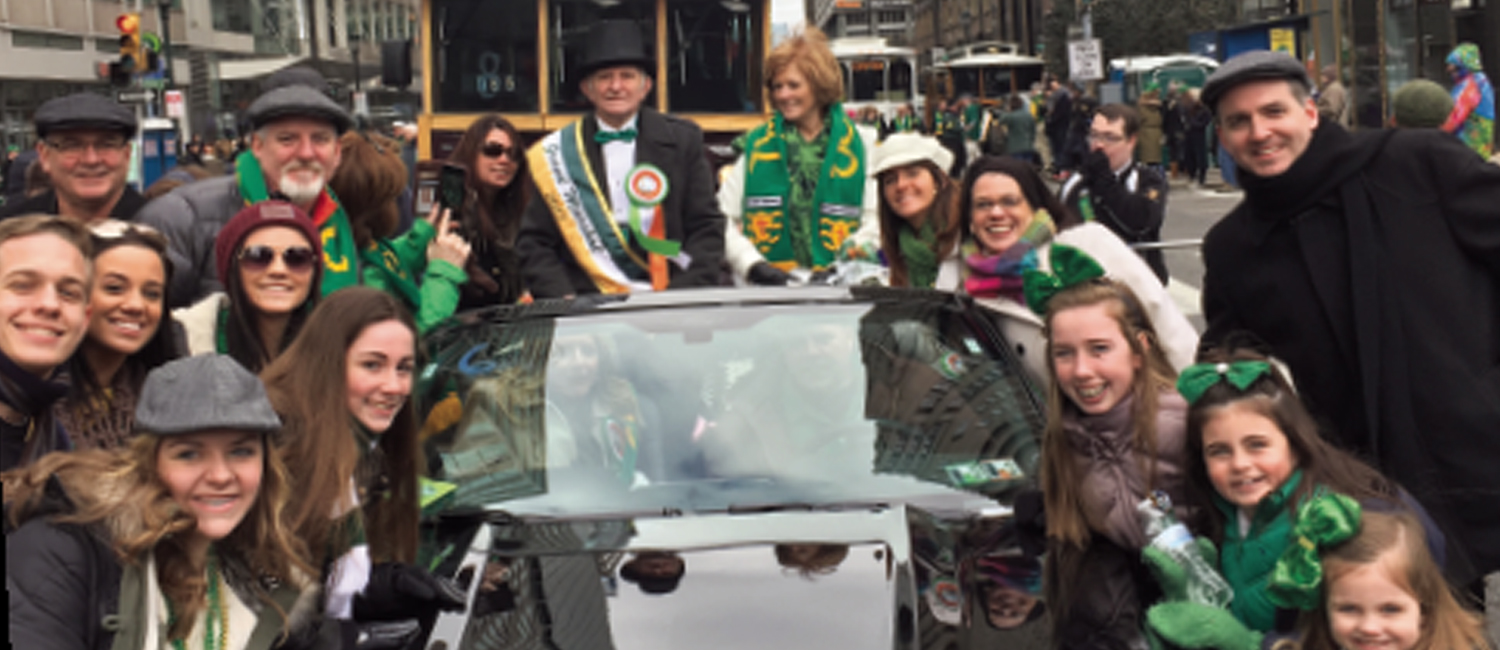JIM MULLEN
Saint Patrick’s Day has always been important to me. As a younger person it meant wearing a green tie to school and attending the annual parish St. Patrick’s Day Variety Show. As I grew older, and as I am older, it refocused my attention to the history, culture, literature, and music of my ancestral home. Erin Go Bragh.
KAREN BOYCE McCOLLUM
(Photo above courtesy of Karen Boyce McCollum)
St. Patrick’s Day is a really special time of year to me. Seeing the excitement in my children when the month of March comes around (which is how I felt as a child) and being able to watch them enjoy St. Patrick’s season with their grandparents is really cool.
Usually our time is spent together as a family around music, dancing, the parades, events at the Irish center, and the ceremony at the Irish Memorial.
My Mom and Dad came to the USA from Donegal many decades ago and instilled in all of us pride in our heritage. They showed us how important it is to stay close to our roots, to carry on the traditions, and how to have fun with it — I think my siblings and I would agree that this was the greatest gift they gave to us.
This quote brings it home for me: “A people without knowledge of their past history, origin, and culture is like a tree without roots.” Marcus Garvey. Thanks Mom and Dad! Bring on St. Patrick’s Day 2020.
MSGR. FRANCIS A. CARBINE
St. Patrick of Ireland and All Our World!
Patron For Persons On Life’s Periphery
“My name is Patrick. I am a sinner, a simple country person, and the least of all believers. I was about sixteen at the time, and I did not know the true God. I was taken into captivity in Ireland.
“After I arrived in Ireland, I tended sheep every day for six years. I remained in the woods and on the mountain, and I would rise to pray before dawn in the snow and ice and rain. As I realize now, the Spirit was burning in me at that time.
“It was one night in my sleep that I heard a voice, ‘Very soon you will return to your native country. Look, your ship is ready.’ After three days we made it to land.
“A few years later, I heard the voice, ‘We beg you, holy boy, to come and walk again among us.’
“How has this happened in Ireland? Never before did they know of God. But now, they have become the people of the Lord.
“This is my ‘Confession’ before I die.”
Patrick wrote his “Confessions” [extracts provided] — his story of discovering faith and mission. He worked in the 5th century when civilization was in collapse.
Patrick also wrote his “Letter to Coroticus” protesting the killing and enslavement of Irish Christians by an English warlord, Coroticus. Patrick is thus the first person known to forthrightly condemn slavery.
In his “Letter to Coroticus” our Saint writes: “I do not know whether to weep more for those killed or those who are captives.”
He calls the predators “wolves and gangsters,” and laments: “My voice is raised in sorrow and mourning.”
ST. PATRICK IS FREEDOM’S CHAMPION AND GOD’S HERO! CELEBRATE WE MUST!
THOM NICKELS
Saint Patrick, the English-born son of a Roman cavalryman was by all accounts a lusty pagan youth. Life changed for him when he was kidnapped by Irish “pirates” at age 16, who forced him to work for many years as a solitary sheep herder in the most deprived conditions.
Life seemed to be over for the young lad until, like Saul of Tarsus, he was struck with a vision or the voice of God. The visions increased until at last he was able to go to France and study in a monastery for a dozen years.
In the year 432, Patrick returned to Ireland with 24 followers to convert the Druids. The rest is history. As for Patrick, he was able to triumph over the most horrendous challenges and restrictions, a testament to the Irish people and their struggles throughout history.
Patrick symbolizes openness to God’s call, unity of purpose, concentration and supreme dedication to a goal. It’s not just the Irish who celebrate this great saint. When Patrick was alive, the Eastern and Western Church were one, so that today one can find icons of Saint Patrick in Eastern Orthodox cathedrals and monasteries.
His universal legacy goes way beyond the shadow of the shamrock.
BILL McCRAY
The meaning and importance of Saint Patrick’s Day to me have evolved over time, inspired by memories of my paternal grandparents. Their inspiration has led to a lifetime of continuous learning about our culture, history, language, and, thanks to the amazing people I have met at the Irish Diaspora Center, our community.
People who only see the day as a caricature celebrated with images of leprechauns, shamrock shakes, and green beer miss so much of what makes the day truly special, what makes being Irish truly special.
The bravery of heroes from Cú Chulainn to Collins, the words of literary lions from Joyce to Doyle, the spirit that survived the tragedies of famine, music and dance expressing our joys and our sorrows, the humor that sustained us through it all, and the diaspora that spread our gifts all around the world.
When I march now in the parade, past the long lines of friendly, enthusiastic faces, I imagine that John and Sara are marching with me and it reminds me of how proud and pleased I am to be Irish.
DR. WILLIAM E. WATSON
Professor of History, Immaculata University
Director of Duffy’s Cut Project
St Patrick’s Day is perhaps the most important day of the year for me, in cultural terms as a professor of history, and also for me as a bagpiper. Reading The Fighting Prince of Donegal about Red Hugh O’Donnell in sixth grade had a huge impact on me, as my Donnelly roots are from Donegal, and I knew then that I had to get into my Irish heritage in a big way.
I have played numerous St Patrick’s Day Parades for Danny Gallagher’s Irish Society (Danny is in this year’s Ring of Honor). It was my honor a few years ago to be in the ring myself for Kathy McGee Burns, alongside such greats as Gerry Timlin and Tom Higgins.
Back in the ‘90s, I played twice each March 17 for Jack Downey at his famed pub, and his second floor was filled with prints of important moments in Irish history. I will always remember his antique print of the execution of Emmett. I met many of the area’s great Irish vocalists and step dancers there.
Some of that magical spirit is preserved in Shawn Swords’ “History of the Philadelphia St. Patrick’s Day Parade.” In the lead up to the great day, I always watch “Waking Ned Divine” and “The Quiet Man.”
A few years ago, prepping for a class on the Troubles, I looked at the St. Patrick’s Day Twitter messages of the Loyalist UDA killer,
Johnny “Mad Dog” Adair, who said that “St Patrick’s Day is the Fenian Ramadan.” After my initial shock at the overt racism of the statement, I thought: “well, perhaps it is so for me” because I know that my yearly March 17 rituals define who I am.
JAMIE O’BRIEN
I was brought up in a London-Irish family, surrounded by family and friends who enjoyed a Saturday night hooley. And each year, when March 17 rolled around … nothing. Nope, there was no mention of St. Patrick, no special activities, just another day. Not that anyone had problems celebrating and enjoying themselves. It’s just that March 17 was simply another day.
Fast forward many years and here I found myself settling in my new land, meeting up with so many others of Irish descent and discovering here was a day to jump up and down and shout out: I’m Irish!!! (Any excuse for a party.)
So, what does it mean to me now that I’m growing old and decrepit and tend to fall into bed soon after I spot Venus in the sky? Well, it means I stay up late because I’m out there playing music. I often ask myself, why do so many venues only have Irish music on and around March 17?
Irish music is so good, it deserves to be heard year round. It can be a tough time for musicians, often playing two or three gigs one after the other at this time. But there again, it is fun and it is lucrative.
I like St. Patrick’s Day…a lot.
JEFF MEADE
irishphiladelphia.com

When I was a kid growing up in Norwich, N.Y., my elementary school, St. Paul’s, put on a little show. Each class was to perform a song. My class sang “It’s the Same Old Shillelagh.”
As the day approached for the show, I distinctly recall my mother sewing a little green vest for me. But a shillelagh—where to get such a thing?
Problem easily solved, as it turned out. My great-uncle William Peter McNulty, son of immigrants Peter McNulty (Mayo) and Anna (nee Hegarty, Roscommon), happened to have one. I was the only kid in the class who sang and danced clutching the real deal, a genuine blackthorn stick.
That was the first time I was even dimly aware of my Irishness. Other than that, it was mostly just a thing to celebrate on St. Patrick’s Day and otherwise forgotten.
It took a long while, well into my adulthood, before the notion of Irish identity began to mean anything to me. I joined Irish Thunder Pipes and Drums in the late ‘90s as a snare drummer, and that opened a whole new world for me — particularly since you had to be a member of Ancient Order of Hibernians Division 1 to belong to the band.
It’s funny, but now, when I think about St. Patrick’s Day, I look back on that little elementary school performance with new eyes and a heightened awareness of my Irish identity and heritage—and that it was because of Peter and Anna that I have something to celebrate. I wish I’d known more about them and their journey then. (And I wish I still had that shillelagh.)
MICHAEL TONER
I have always found it ironic that there should be two Saint Patrick’s Cathedrals in Armagh, the ecclesiastical seats of two separate rites, one Roman Catholic and one Church of Ireland, as if even in bringing Jesus’s message to Ireland there would eventually be division and a sense of “otherness” between these parallel Christian neighbors.
In his early conversion encounters with the native Druids, Saint Patrick met with the common yet extraordinary reply, “We know about him,” paving the way for a facile reception of Patrick’s “Good News” among the Irish. Clairvoyance to this day remains common in the west of Ireland.
If anything, I should hope that Saint Patrick and his special day stands for a genuine sense of acceptance and communion with “the other,” with the downtrodden and less fortunate of this world, sharing a view toward The Otherworld, a befriending of strangers and a making of neighbors in the cause of world peace.
Or, as Saint Patrick himself, Ireland’s first and foremost Paddy, might instruct us, “Pax tibi, Pax mundi.”

